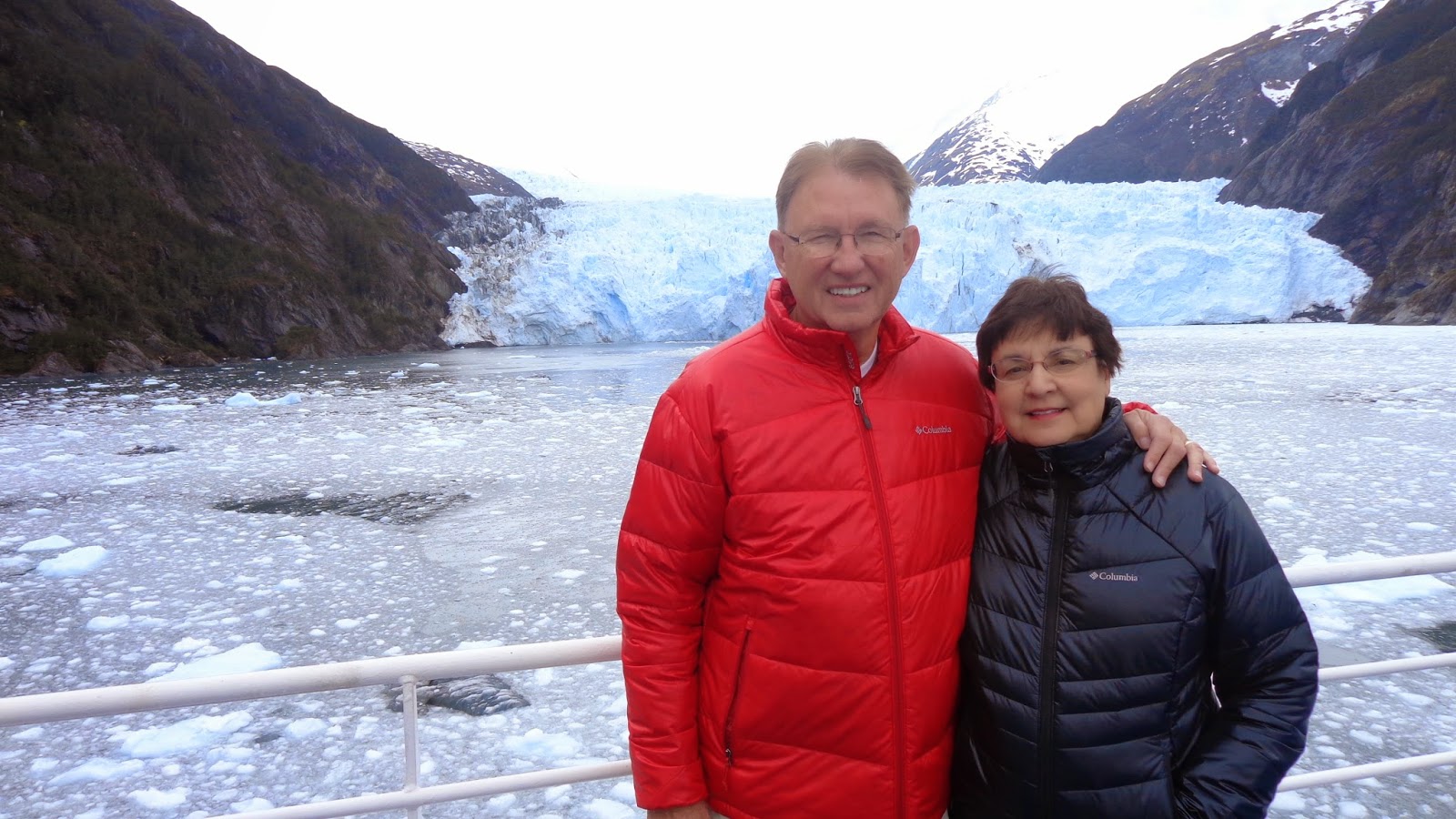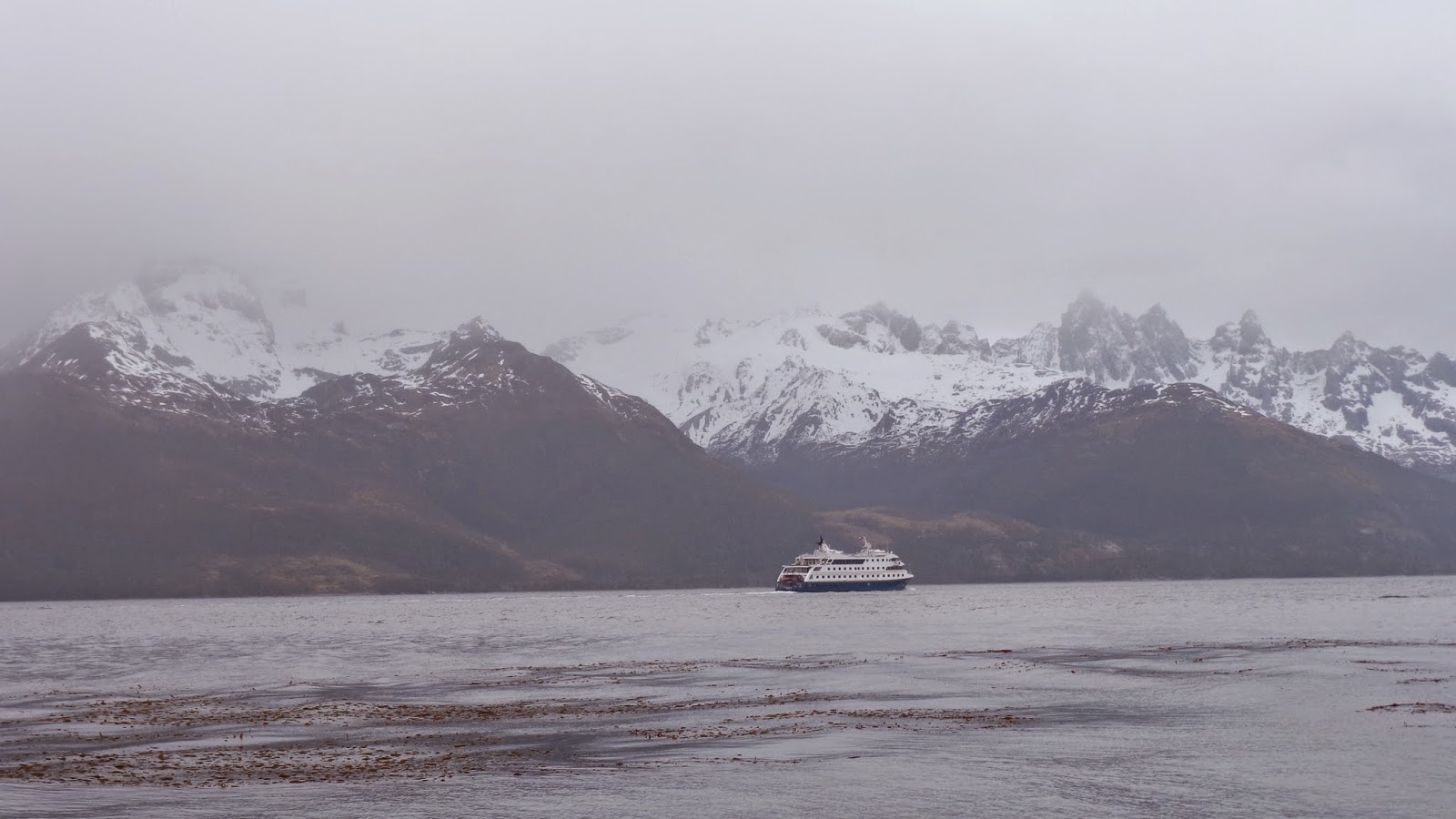
We arrived in Punta Arenas, the capital city of Patagonia, in the early morning and said good bye to the ship and the crew of the Australis. We had lunch in Punta Arenas and a quick tour of this port city in Chile. It was founded in 1854 by colonizer Vicente Perez Rosales as a lake sailing center and commercial to Puerto Montt. Some years later Bernardo Phillippi encouraged settler activities with the discovery of Lake Llanquihue. The commune of Puerto Arenas was legally created by the Chilean government on December 30th 1927. Tourism first started in 1934 with the inauguration of the Hotel Puerto Arenas, today a casino, and increased a short time later with the opening of the road to Ensenada along the southern shore of the lake. Today the town is a lakeside resort with a growing population of people going to work in Puerto Montt.
 |
| Flag of Patagonia |
 |
| Puerto Arenas |
 |
| Lunch in Puerto Arenas restaurant cooking lamb. |
After a long leisurely lunch we boarded our bus for the six hour ride to the hotel in Torres del Paine National Park. The ride provided outstanding viewing of the countryside and the many animals that roam the plains of the beautiful country.
 |
| Rhea |
Traveling along the highway we saw many Rhea. This bird is related to the Ostrich. Rheas are from South America only and are limited within the continent to Argentina, Bolivia, Chile, Paraguay, Peru, and Uruguay. They are grassland birds and both species prefer open land. Rheas tend to be silent birds with the exception being when they are chicks or when the male is seeking a mate. During breeding season, the male will attempt to attract females by calling. This call is a loud booming noise. During the non-breeding season they may form flocks of between 20 and 25 birds. When in danger they flee in a zigzag course, using first one wing then the other, similar to a rudder. During breeding season the flocks break up. For the most part, rheas are vegetarian and prefer broad-leafed plants but they also eat fruits, seeds and roots, as well as insects such as grasshoppers and small reptiles and rodents. Young rheas generally eat only insects for the first few days. Outside of the breeding season they gather in flocks and feed with deer and cattle.
Shortly after the Rhea, we spotted Andean Condors. The Condor is a South American bird in the vulture family. Found in the Andes mountains and adjacent Pacific coasts of western South America, the Andean condor has a wingspan of up to 3.2 m/10.5 ft
but is exceeded by the wandering albatross. (at up to 3.6 m/12 ft).
It is a large black vulture with a ruff of white feathers surrounding the base of the neck and, especially in the male, large white patches on the wings. The head and neck are nearly featherless, and are a dull red color, which may flush and therefore change color in response to the bird's emotional state. In the male, there is a wattle on the neck and a large, dark red comb or caruncle on the crown of the head.
The condor is primarily a scavenger feeding on carrion. It prefers large carcasses, such as those of deer or cattle. It reaches sexual maturity at five or six years of age and nests at elevations of up to 5,000 m (16,000 ft), generally on inaccessible rock ledges. One or two eggs are usually laid. It is one of the world's longest-living birds, with a lifespan of over 70 years in some cases.The Andean condor is a national symbol of Argentina, Bolivia, Chile, Colombia, Ecuador, and Peru.
 |
| Two Andean Condors taken at a distance. They were feeding on a dead cow. |
|
The next morning we awoke to a beautiful scene of the Torres del Paine National Park from our bedroom window. The rest of the two day would be spent exploring the park and viewing its wonders of mountains, animal life, streams, and water falls.
 |
| From our bedroom window in the morning. |
 |
| Hard to see but our hotel is in the distance. The beauty of the valley is outstanding. |
Much of the geology of the Paine Massif area consists of cretaceous sedimentary rock.
Orogenic and erosional processes have shaped the present-day topography, and glacial erosion is mainly responsible for the sculpturing of the massif in the last tens of thousands of years. A good example of the latter is the
Cuernos del Paine, whose central bands of exposed granite contrast strongly with the dark aspect of their tops, which are remnants of a heavily eroded sedimentary stratum.
In the case of
Las Torres, what once was their overlying sedimentary rock layer has been completely eroded away, leaving behind the more resistant granite.
 |
| Notice the glacier hanging of the face of the mountain |
The mammal we encountered was the Guanaco. Guanacos are the parent species of the domesticated llama. The guanaco is native to the arid, mountainous regions of South America. In Chile and Argentina, they are more numerous in the regions of Patagonia. In this area, they have more robust populations, since there are limitations on grazing competition from livestock.
] A guanaco’s typical lifespan is 20 to 25 years.
Estimates, as of 2011, place their numbers at 400,000 to 600,000.
Guanacos live in herds composed of females, their young and a dominant male. Bachelor males form a separate herd. While female groups tend to remain small, often containing no more than ten adults, bachelor herds may contain as many as 50 males. When they feel threatened, guanaco alert the herd to flee with a high-pitched bleating call. The male will usually run behind the herd to defend them. They can run with a speed of 56 km (35 mi) per hour, often over steep and rocky terrain.
They are also excellent swimmers. Guanacos are one of the largest wild mammal species found in South America .
 |
| Guanaco |
 |
| A herd |
 |
| The Great Guanaco |
Click on the banner and get free shipping for ordering from Gander Mountain.
 Click on the link and go to my home page and buy gear. You cannot own enough.
Click on the link and go to my home page and buy gear. You cannot own enough.
Good hunting, good fishing, good luck. Hank
text
xxxxx






















.jpg)